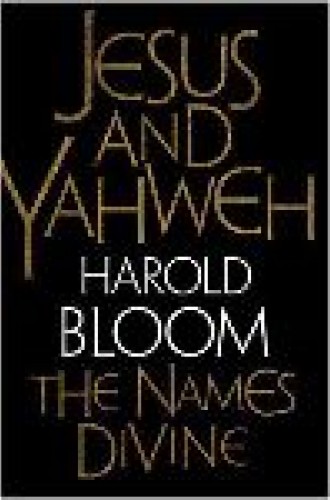Jesus and Yahweh
Yale’s distinguished literary critic and more-than-amateur, but less-than-professional religionist Harold Bloom treats readers to a profoundly humane internal dialogue between Yeshua (Jesus) of Nazareth, Jesus Christ, and Yahweh. To this central cast, Bloom adds other characters and names along the way: God the Father, the Ein-Sof of mystical Jewish Kabbalah, the American Jesus, the Holy Spirit of the Pentecostals. For Bloom, the characters in texts are real, and thus they are real in his experience—and, by extension, in ours as well. In Bloom’s literary approach, Jesus of Nazareth and Jesus Christ are very different personae. The fiery tempered, “human, all-too-human” Yahweh (rendered by Bloom with vowels) is nothing like the Hellenistic, unfeeling, omnipotent God the Father.
Theologically inclined and historically informed readers may be disconcerted by Bloom’s passionate, rough-hewn literary approach. Bloom recognizes that Christians will find the book’s claims unacceptable. That may be true, but I hope that many Christians (and others) will read it. What they will find is a startlingly honest reflection by one of the most serious readers of our time.
Bloom deals with the Hebrew Bible (Tanakh), the Old Testament (which is not, in his view, identical to the Hebrew Bible), the Gospels, the masters of Kabbalah and the founding rabbis of so-called rabbinical Judaism, all against a backdrop of references to Tyndale, Shakespeare, Cervantes, Milton and others. High literature, the gnosis of strong poets, is Bloom’s religion. References to these classical authors intensifies his reflections on Yahweh and Jesus. Yahwehlike, the book reverberates with Bloom’s emotions: he is variously shocked, drawn in, baffled, appalled and daunted by the texts he discusses.
Bloom knows so much that most readers will find (as I did) that some of the references and comparisons raise questions rather than provide answers. Indeed, Bloom raises questions that even he cannot answer. Passionate indecision is one of the keys to his approach, which, in Bloom’s own telling, is a thoroughly Jewish, albeit heretical, trait. This waveringly subjective style alone—so unlike most overcertain religious discourse of our day—makes the book worth reading.
Bloom insists that he is not a believer, that he is not one to entrust himself to the covenant, but he anguishes over the literary persons of Jesus of Nazareth, Jesus Christ and Yahweh, and his unbelief evokes these figures more credibly than the belief of most others. A personal quest seems to motivate Bloom’s anguish: he concludes Jesus and Yahweh with a lament, wondering whether the “self-exiled” Yahweh will “make a covenant with us that he both can and will keep.” Since the Holocaust, that seems a good question for both Jews and non-Jews to ask.
Though he is an unbeliever, Bloom is not anchorless. He refers to himself as a gnostic who wavers toward agnosticism. Of the various images of Jesus, the Jesus of the Gospel of Thomas appeals to him most. No crucifixion, no resurrection—just sayings that “ring true” to the author. Most of all, Bloom, whose “awe of Yahweh” is rooted in childhood memories, is drawn to the Yahweh of J, the major authorial strand of Genesis, Exodus and Numbers, which was spooled together with other sources (the Elohist, Priest and Deuteronomist) to form the Torah.
The Yahweh of J appeals to Bloom because he is such a rich character—not very divine on Christian or Greek terms, but so multivalent, personally enriched and evocative that he is both all too human and a fusion of the divine with the Torah itself. Only the Gospel of Mark’s Jesus and the Qur’an’s Allah come close to this, in Bloom’s reading. Mark’s Jesus is pure enigma, never subject to our predilections. Allah, whose name is, for Bloom, another name of Yahweh, is so cantankerously divine that his judgment of the earth inspires terror. Love is not on the short list of his characteristics.
Bloom’s gnosticism is reflected in his dismissal of scholarship that seeks to reconstruct the Jesus of history. He believes such quests to be quixotic, a view he shares with most Christians, who simply identify the New Testament Jesus as the Jesus of history. However, Bloom is as multivalent as J’s Yahweh, and he draws upon the work of historians such as John Meier and Raymond Brown to frame basic convictions about Jesus of Nazareth. Although Bloom’s reading is enhanced by these references, I wish that he would broaden his scope of dialogue to include the likes of John Dominic Crossan, Marcus Borg and other serious “questers” of our time. These authors may fall prey to Bloom’s conviction that those who quest for the historical Jesus find instead “their own” Jesus, but their approach does represent a historical and covenantal alternative to gnosticism.
The anguish of Bloom’s struggle with Yahweh—the reader pictures him wrestling with God at the Jabbok—is essentially about the reliability of covenant. In Bloom’s view, whereas Christianity asks for belief, and Islam asks for submission, Judaism asks for trust in covenantal reliability. Bloom ultimately finds himself unable to trust in the covenant, yet he continues to hear the poetry of each of these religious perspectives. In my view, Yahweh’s covenant already includes those who wrestle mightily against him. That view may be rooted in residual awe of my childhood God, but I believe it to be a considered theological alternative.






